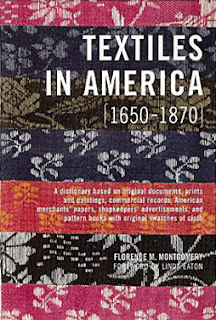Wool Quilt from about 1790-1840
Collection: Watkins Museum, Lawrence, Kansas
This is the oldest quilt in the collection of our local historical society. Years ago when I read the catalog papers it was described as Amish. You can understand the mistake. In Kansas we see a lot more Amish wool quilts than we do early wool petticoat quilts, which is what it actually is, probably brought here by one of the New Englanders who came to Kansas in the 1850s.
I wish I'd taken better pictures but I remember it as quilted with many fancy motifs. When it was turned over, the shapes on the front were echoed on the back. It was obvious that the center blue panel had been a quilted petticoat. The gathers had been removed and the skirt flattened out. Smaller pink square filled out the rectangle and a border of tan quilted wool was added with larger pink squares.
Fashion in the last quarter of the 18th century
The woman on the right is wearing a quilted petticoat. It's important to remember that the word petticoat really means skirt. Quilted petticoats were worn on the outside in the 18th century and into the 19th.
See two petticoat quilts at the Quilt Index
These recycled petticoat bedcovers are rather common in museum collections (if not always recognized). Like the linsey-woolsey quilts described in the last post, wool and silk petticoats were too durable to discard once they were unfashionable.
See this quilt made from a petticoat in the collection of Old Sturbridge Village
Another madder red quilted petticoat in England.
The joke is that the cobbler's wife is aping her betters---
and making do without a lady's maid.
Wool petticoat from the collection of Colonial Williamsburg.
Go to their search page, type in petticoat and see many examples:
While we are thinking about wholecloth quilting, here's a great reproduction.
Underhill Tree of Life Wholecloth Quilt
by Jill Meszaros, 2012
Cotton and hand quilted.
Cotton and hand quilted.
Jill's entry into the 1812 Seaways Trail Quilt Challenge was named for her ancestor Major David Underhill of Ohio. Her hand quilting design inspirations: Lynne Z. Bassett's drawings in Massachusetts Quilts and a "Tree of Life Whitework Quilt" from Quilts-Masterworks from the American Folk Art Museum.
See more about this quilt that won second prize for Viewer's Choice here:
If you are inclined to make a petticoat...click here:




















































